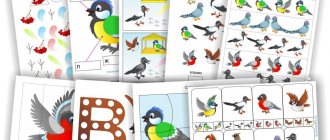Article:
Goal: To teach children to write a descriptive story about migratory birds.
Tasks:
Clarify and update children's vocabulary on the topic
Fix the names of migratory birds in the nominative singular and plural cases
Teach children how to make a newspaper
Strengthen the ability to draw, paste, and practice modeling
Understand the structure of birds, external signs
Equipment:
Cut-out pictures with migratory birds
Sketchy pictures of birds flying away
Whatman paper, glue, ball, magnetic board
Tape recorder, microphone, audio cassette with music
Progress of a lesson on the development of coherent speech in the senior group
Organizing time
The speech therapist and children stand in a circle. There is a knock on the door and a “correspondent” (educator) of the Lesnaya Gazeta newspaper enters.
Speech therapist: Hello, who are you?
Educator: Hello, I am a correspondent for Lesnaya Gazeta. Today, kids from a neighboring kindergarten called our editorial office and asked the editor to send them a newspaper about migratory birds. Kids want to find out who migratory birds are.
They can't read, so they need to draw a newspaper. I brought paper, glue, and pictures for the newspaper. Can you help me make a newspaper for the kids?
Speech therapist: Well, guys, let’s help the kids? Let's remember the names of which migratory birds do you know? (Children ask each other riddles.)
Conversation with children about autumn
Speech therapist: We remembered the names of migratory birds. Why are they called that? (Children's answer). The departure of migratory birds to warmer regions is one of the signs of autumn. What other signs of autumn do you know? (Children's answers). Children's answers are assessed.
Speech therapist: In autumn, people say goodbye to migratory birds. Let's say goodbye to them too. I will read a poem and perform the movements, and you repeat the movements after me. (Quiet music sounds. The speech therapist reads a poem, and the children perform movements in time with the words).
Fizminutka
Autumn is a bad weather, (raise your hands up)
The poplar has turned yellow. (torso tilts left - right)
Suddenly there is a squirrel on a branch (arms to the sides)
Sang a song. (torso turns left - right, arms to the sides)
The branch sways slightly (hands forward)
The rain doesn't stop (Bends the body back and forth)
The old skvorushka is with us
Says goodbye to spring (Squats)
Speech therapist: Guys, who was the poem about? (Children's answers). That's right, the starling says goodbye to us, he flies away to warmer lands. Do you know how starlings fly away when they all get together?
Lexico-grammatical games and exercises
Game "How do birds fly away?"
Speech therapist: I will say a sentence, and you will help me finish it.
(After the children answer, a schematic picture is displayed on the board).
Educator: I’ll ask you guys to find a suitable picture for this sentence and paste it into the newspaper.
Swallows, rooks, starlings fly away... (in a flock).
The cranes fly away... (with a wedge).
The cuckoos fly away... (One by one).
Ball game "One - many"
Speech therapist: I name a bird, and you name me a lot of birds.
(The child catches the ball and returns it to the speech therapist, saying the name of the birds in the nominative plural).
Heron - herons, rook - rooks; crane - cranes; stork - storks; cuckoo - cuckoos; starling - starlings; swallow - swallows.
The game “Which bird is missing?”
Speech therapist: And now the pictures with birds will hide from you, and you tell me which bird is gone. (Children close their eyes, and the speech therapist removes one picture at this time. The game is repeated 4 - 5 times. Children give the answer in the genitive case according to the model: The heron is gone. The rook is gone. The cuckoo is gone. The stork is gone. Etc. .)
Development of coherent speech. Writing a descriptive story
Educator: Guys, let's go back to our newspaper. Our newspaper should have pictures with birds. The kids played with the pictures and accidentally cut them. Find yourself a friend with whom you will collect the picture. (Children collect the cut pictures into a whole one, name the resulting migratory bird and paste the picture into the newspaper).
Speech therapist: Now you and your friend tell us about your resulting bird. And these diagrams will help you. (The speech therapist gives an example of composing a descriptive story about a migratory bird according to a diagram. Children in pairs compose a story. The first child is the beginning of the story, the second is the end).
Educator: And I will record your stories on tape. Kids will look at our newspaper and listen to your stories, so they will learn about migratory birds.
Summarizing
Speech therapist: Dear correspondent, is your newspaper ready?
Educator: Yes, the newspaper is ready. I think kids will really like it. Look what a wonderful newspaper we have made.
Speech therapist: Today we remembered many migratory birds. They helped the correspondent make a newspaper for kids, and even recorded the stories on tape. Children will be able not only to see, but also to hear about migratory birds. It would be interesting for kids to hear a poem about migratory birds. Maybe some of you know such a poem? (The child recites a poem).
Educator: Thank you very much, guys, for your help: for the pictures, for the stories and for such a wonderful poem. It’s time for me to take the newspaper to the kids at the neighboring kindergarten. Goodbye! (Leaves).
Speech therapist: Guys, I really liked the way you played today, answered questions, talked about birds, what kind of newspaper you made for the kids.
